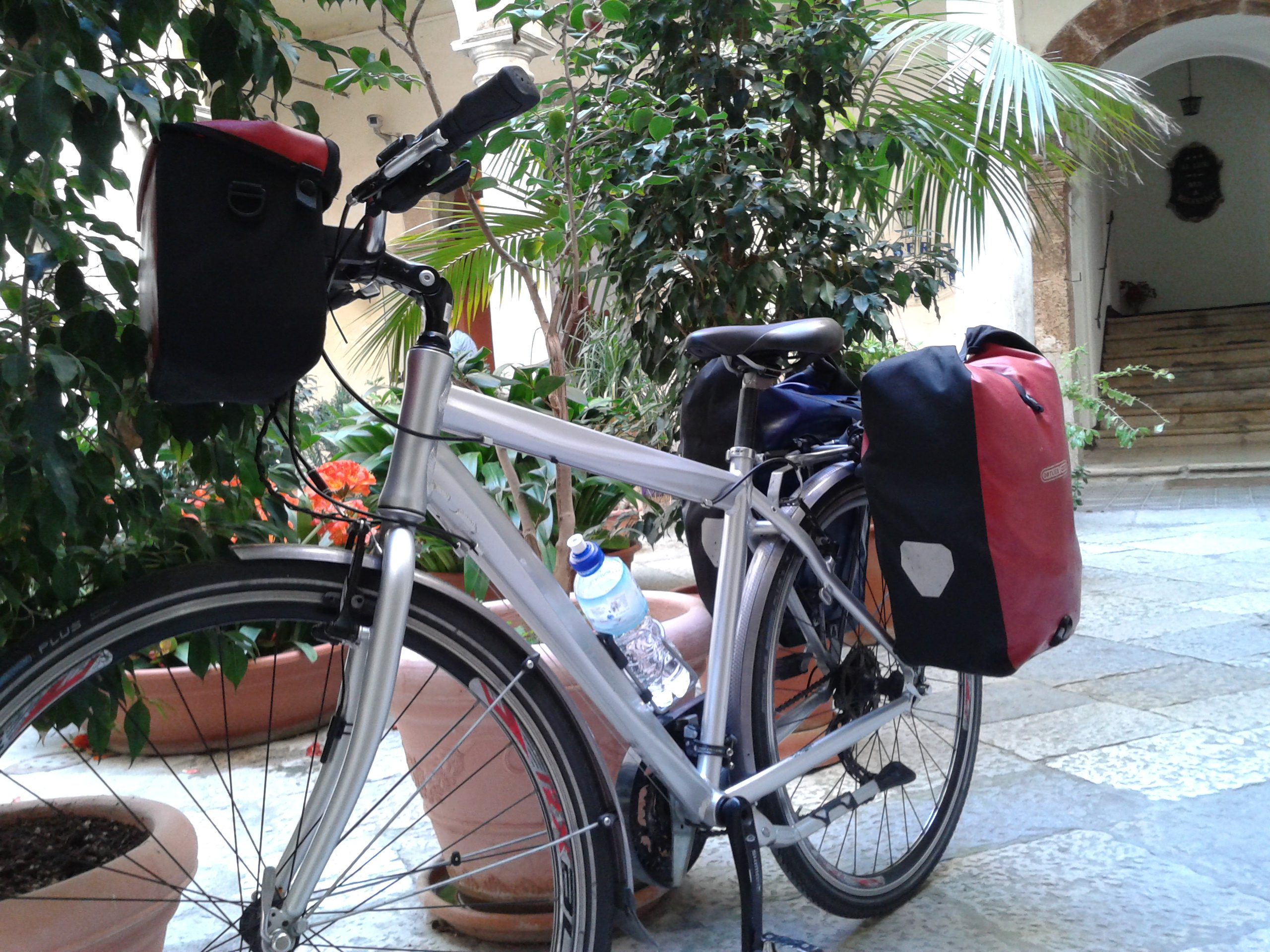A touring bike must be, most of all, comfortable, and for this reason steel frames are the best choice, also because they are the easiest-to-repair ones during long solitary journeys and in remote places. To whom can afford it, I advice to take a titanium frame, because it is almost as light as aluminum and sufficiently elastic.
Inox-ray wheels and tires which are a little bit larger than those of racing bikes allow you to face any pavé and to spare your wrists to suffer from pebbles. For this reason one of the most chosen solutions is cyclo-cross layout.
Triple crankset and light ratios allow you to overcome any kind of uphill. Like in real life 😉
Saddle?.. Brooks. Since I’ve started I cannot stop using it. Yeah, it is a bit heavy, but… it would be more proper and wiser for me to loose some extra-weight from my belly-button than saving 100 gr. from the saddle 🙂 You must also say that each ass needs its saddle, and diverse smart shops give the possibility to try their test-saddles for some days, until you find the most suitable one. Ah! super-cushioned saddles, gel saddle-covers and similar things should be left to old ladies.
The right handlebar for tours must let you change position; as a consequence, the choice is between straight and dropped handlebar.
Straight handlebars allow you to enjoy the panorama with the best control (also because the brakes are easier to be found) but your hands stay always in the same position. Dropped handlebars offer you more positions, but by staying on the drops (classical road bike position) you cannot see the landscape. Because of this, the best solution is cycle-cross handlebar with compact drops; some companies are producing specific handlebars for bike journeys, that is to say with drops that in their ends go outside. In the end there is the handlebar best loved by German and Dutch people – shaped almost as an 8 – comfortable definitely, but also a bit heavy.
The right pedals for a bike journey are both SPD and Crank Brothers (MTB type), simply because it is easier to walk with such shoes… You’ll agree with me that it’s a little embarassing to walk into a restaurant like a duck 🙂
Rack and luggage (for independent journeys).
A rack should never break, but aluminum ones have usually this problem. The state of the art is, also in this case, titanium, but a series of titanium rack costs as much as a bike. So you ought to pay attention to the installation phase, e.g. by inserting rubber joints between rack and frame, which can take up the vibrations.
What about bags? Some friends of mine are able to ride their road bikes without any bags (during the summer, when you don’t need heavy clothes).
On the other side, you find those people who carry as much as it is possible with them, tent and camp stove included, and I saw even some 40 kg luggage! Personally, I can fit my luggage in a 10 kg Ortlieb (lateral bag), if I don’t camp.
Those who ride “light”, or in MTB, usually decide to distribute the weight in a more aerodynamic way, in fact when you exceed 20 km/h the resistance of the lateral payload becomes noteworthy!.. See this complete article on the web-site bikepacking.it
https://www.bikepacking.it/attrezzatura_bikepacking.php
Ah, 26″ (MTB-first generation) or 28″ (road) -wheel diameter?
Hard to decide: in a nutshell, for distances longer than 120 km a day it is better the bigger diameter; if you travel in remote areas, it is better the 26″ because the tires are more robust and easier to find and fix.
https://cyclingabout.com/index.php/2011/12/700c-vs-26-inch-wheel-size-for-touring/
Among my favorite 28″-touring bikes:
“Randa” by Orco (I promise I’ll buy it, sooner or later)
https://orcocicli.com/Biciclette/Pagine/Randa.html#7
“Vaya” by Salsa, with a disassembling frame, you can easily travel with it, without paying the specific flight fee for this type of luggage!
https://salsacycles.com/bikes/2014_vaya_travel
But the most important thing is that the bike must be in decent conditions.
That it is not to say that you need the up-to-date or the top-model, but that, simply, brakes must be capable of slowing down the bike, the wheels of turning and the gear of shifting. Well.
To those who want to buy a bike and don’t have much money to spend, my suggestion is: take a good second-hand bike instead of a heavy-but-new one! You’ll spend the same but you don’t produce additional waste to be thrown away. What sad bikes are those with brakes which don’t go back to their original position, with rusty chains, made of poor quality components…leave them to shopping centres!..
I would like to share a thought – wonderful to me – of Orco Cicli friends:
«Well made things are not just for the rich. They last a long time and when they get old you repair them. The art of the craftsman is not threatened by impoverishment but by the vulgarity that criminalizes its culture. Purchasing something is an individual necessity, sometimes a sacrifice, not a casualness caused by imitative neurosis. We are exhausted survivors of the scrapping and disposability of products»
Enjoy your bike![:]


